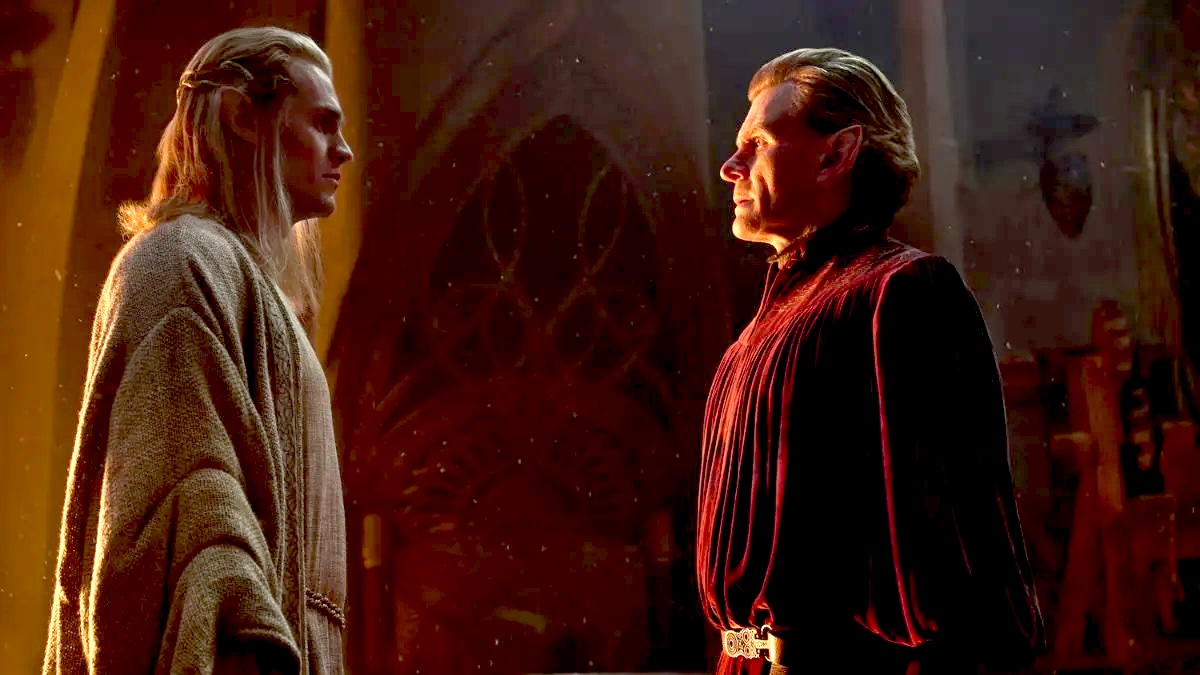So what’s up with ‘Rings of Power’s confusing timeline?
Whatcha doin' with Tolkien's sacred timeline, bruh?

The Lord of The Rings: The Rings of Power adapts the elusive Second Age of J.R.R. Tolkien’s history of Middle-earth, which has been sparsely chronicled in the appendices of The Lord of The Rings, and related works like Unfinished Tales.
For an age that witnessed the forging of the rings of power and the One Ring, followed by a major war between the elves and Sauron, the fall of the island kingdom of Númenor, and the founding of the elven refuge of Imladris, a.k.a. Rivendell, the Second Age is not as fleshed out as the First Age is in The Silmarillion or the Third and Fourth Ages are in The Lord of The Rings. With The Rings of Power relying heavily on the appendices to LOTR to forge their adaptation, it’s a tricky quest to create something that appeals to both Tolkien fans and new audiences.
The Second Age of Middle-earth begins with the founding of the Grey Havens and Lindon, as well as Númenor, whose first king is Elrond’s brother, Elros Tar-Minyatur. And it spans roughly 3500 years. One of the biggest criticisms then leveled against the Prime Video series is that it’s got the Second Age timeline all wonky, which, in turn, affects the presence and arcs of several major characters in the series.
For example, in the year SA 300, Galadriel had already given birth to her daughter with Celeborn, Celebrían. Or that in the year SA 1500 the rings of power were forged and Sauron had revealed himself, after which the three elven rings of power were forged in an attempt to thwart him. However, in the show, Celeborn is lost, Galadriel’s daughter doesn’t seem to be born yet, and the three elven rings are forged by Celebrimbor before the other rings of power.
Another example would the overlap of the War of the elves and Sauron with that of the political turmoil in Númenor in the show. Because as per the timeline in the books, Míriel, Pharazôn, and Elendil were born only 1500 years after the war of the elves with Sauron and the forging of the One Ring!
So, umm, what’s up with the timeline of The Rings of Power, eh?
Well, one thing that showrunners J.D. Payne and Patrick McKay have maintained is that they’re adapting their own version of story, and not necessarily following the timeline rigidly. It’s why we have The Stranger, who many fans are convinced is Gandalf, arrive in Middle-earth in the Second Age instead of the Third Age, because only two Blue Wizards are said to have arrived this early in the story. (And anyway, a wizard arrives precisely when he means to!) Or the Balrog, known as Durin’s Bane has awoken in the Second Age in the series, when in the books, it awakens in the year 1980 of the Third Age, during the reign of Durin VI.
And you know what? That’s actually okay, to not be so rigid with the timeline. Because here’s the thing—three and a half millennia is a long, long time to condense into one five-season TV series! Can you imagine the time jumps over long periods of time where Sauron is just chilling, incognito, or amassing support in the East, and so nothing major happens? It would be instant death for the show! Moreover, not having the Istari as part of the story would feel wrong, but since not much is known about the workings of the Blue Wizards, how would they be included in the story?
What The Rings of Power has been doing then is smooshing events that are separated by hundreds and even thousand years into a parallel timeline for a more cohesive story with thrilling jeopardy in the paths of its main characters. So not Galadriel not having a husband or a daughter just yet means she isn’t tied to family and therefore only has her dark obsession to avenge her brother and find Sauron to dwell on. It makes Sauron’s seduction of her make more sense, as he tries to touch her the light he sees in her, which she still carries despite all that she’s been through.
By bringing up the upheaval of Númenor’s politics, it juxtaposes the turbulent times and the departure from the right path for the elves and the dwarves with the men, thus making it easy for Sauron to corrupt every race. It’s essentially showing us that these are testing times for all, and it is in these moments that darkness can seep in if you let it, or heroes rise, defined by their actions. By giving Halbrand a glimpse of the island’s power and prosperity and the eventual part they’ll play in his downfall will also make Númenor ripe for Sauron’s revenge ploy that ought to happen sometime in the third or fourth season of the series.
All in all, if you’re a show viewer, you’ve got nothing to fuss over and simply enjoy the show. But if you’re a Tolkien nerd who is shaking their fists at the absence of Glorfindel and Celeborn, or the skewed timeline in The Rings of Power, know that the show is doing its own thing but rest assured, the Tolkien estate has signed off on it. And as long as the ultimate fate of the characters isn’t altered, the show can play around a little for cinematic impact!
The Lord of The Rings: The Rings of Power season 2 is all set to arrive with a three-episode season premiere on August 29, 2024, on Prime Video, with weekly releases for the remaining five episodes.
Have a tip we should know? tips@themarysue.com